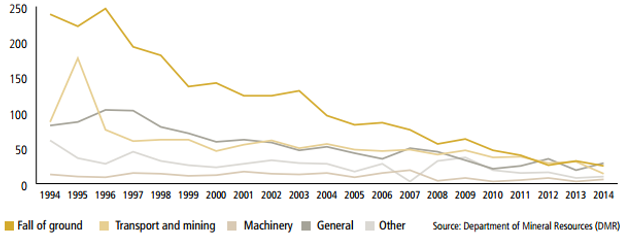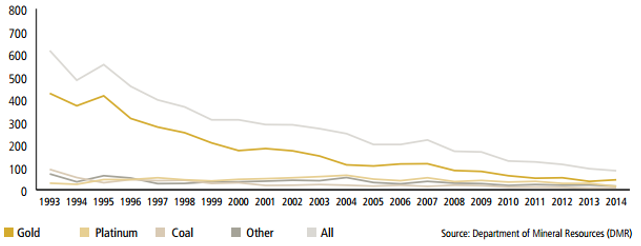Reasons
Rock-related hazards continue to be the single largest cause of injuries and fatalities on South African mines, making up close to 30% of all fatalities in recent years.
While rock-related fatalities comprise a more serious issue in some mining sectors and commodities than in others, in general their control and elimination is a crucial element in helping the industry reach its milestones and the eventual target of zero harm. Most rock-related injuries and fatalities occur near the active mining face, whether this face is a tunnel or stopeand in the access-ways to the mining faces. These areas are where the rock is most unstable, as it has been recently exposed by blasting, is adjusting to new stress environments, is sometimes unsupported and is possibly even subject to dynamic conditions such as seismicity.
Cause of fatalities 1994 - 2014

Causes of fatalities 2007 - 2014
| 2007 | 2008 | 2009 | 2010 | 2011 | 2012 | 2013 | 2014 | |
|---|---|---|---|---|---|---|---|---|
| Falls of ground | 76 | 56 | 63 | 47 | 40 | 26 | 32 | 25 |
| Transport and mining | 48 | 41 | 47 | 37 | 38 | 29 | 31 | 14 |
| Machinery | 19 | 4 | 8 | 3 | 5 | 8 | 3 | 6 |
| General | 50 | 45 | 33 | 21 | 25 | 35 | 19 | 29 |
| Other | 3 | 32 | 37 | 19 | 15 | 16 | 8 | 10 |
Mining fatalities per commodity 1993 - 2014

The purpose of TARP is to ensure that the area in which stope crew members are using as access ways or performing most of their work are thoroughly assessed before entry and that, if falls-of-ground hazards are identified, the situation will receive the appropriate attention at the appropriate level of management and expertise.